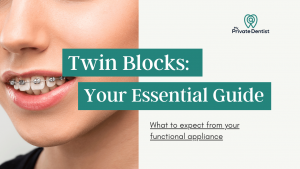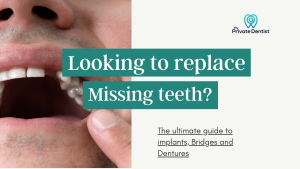Thinking about ceramic braces?
Ceramic braces are popular because they are less visible compared to metal braces. They both work in the same way to align teeth, but use tooth coloured brackets which are less noticeable. Clear aligners, such as Invisalign, are another option for discreet brace treatment, but may not be suitable for some complex cases, making ceramic braces a better option in these situations.
If you’re considering ceramic braces to improve your smile, you’re not alone. As a dentist who provides orthodontic treatments, I’ve seen an increase in the demand for adults wanting ceramic braces to align their teeth.
As with any dental treatment, ceramic braces have their pros and cons, and it’s essential to consider them before making a decision. In this article, I aim to address some of the most common concerns patients have about ceramic braces to help you decide if they’re the right choice for you.
Ceramic braces vs metal braces: which is better?
When it comes to choosing between ceramic and metal braces, the decision ultimately depends on your priorities. For their ability to straighten teeth, metal and ceramic braces are the same.
Having opted for ceramic braces to align my own teeth, I was attracted to the fact that they are more discreet. However, the elastic ties around the brackets stain easily, and can start to appear yellow.
Ceramic braces are more expensive than metal braces yet are more prone to breakage, requiring extra orthodontic visits for repair. Ceramic brackets can damage/chip the enamel of opposing teeth, and so are less advisable for patients who clench, or have a strong bite.
Click here to find out more about different types of braces.
Ceramic braces are aesthetic
One of the most significant benefits of ceramic braces is their low visibility. The tooth-coloured or clear brackets blend in with the natural colour your teeth, making them far less noticeable than traditional metal braces. Remember, the wire running through the brackets is still metal in ceramic braces, and can be seen.

Ceramic braces are versatile
Ceramic braces work in the same way as traditional braces, using wires to apply steady pressure to align teeth. They are an excellent option for correcting:
Crowding: teeth overlapping or misaligned are easily corrected with fixed ceramic braces.
Spacing: attachments are placed on brackets to close gaps between teeth. In comparison, clear aligners such as invisalign are limited in amount of space closure they can reliably achieve
Overbite/open bite/crossbite: Issues to do with how upper and lower teeth meet together. If they are interferences, ceramic braces are suitable for helping to correct this
Overjet: The space between the position of the upper incisors and the lower incisors. Ceramic braces, with the help of elastics, can help to improve this.
Ceramic braces are less allergenic
If you have a nickel allergy, ceramic braces may be a good option for you. Unlike metal brackets, ceramic brackets contain no nickel. Orthodontists can also use nickel-free TMA wires with ceramic braces, further reducing the risk of an allergic reaction.
BUT
Ceramic braces are more expensive
Ceramic braces are more expensive than metal brackets. Ceramic braces cost £3500-£4000, though this can vary depending on clinic or region. Metal braces range between £2800-3500.
Ceramic braces are usually cheaper than clear aligners, such as Invisalign which cost upwards of £4500, and lingual braces which can cost £7000 or more.
This price difference may be a significant factor in your decision, especially if you have a limited budget.
Ceramic brackets can come off
Studies have shown that ceramic brackets don’t stick, or bond, as well to teeth as metal brackets. They are more than twice as likely to come off [1], and needs promptly replacing by your orthodontist.
Ceramic brackets are brittle
Ceramic brackets are not as strong as metal ones and may fracture or chip more easily. Consider a metal brace instead if you have a strong bite, or grind your teeth. Patients who wear ceramic braces need to be careful when eating hard, crunchy, or sticky foods to avoid damaging their brackets.
You should wear a mouthguard to protect your teeth and ceramic brace, if you play contact sports.
Due to the brittle nature of the ceramic brackets, they can be more difficult for the orthodontist to remove at the end of brace treatment
Ceramic brackets are more bulky than metal brackets
Ceramic brackets are larger and more bulky than metal brackets. This can make them harder to clean, and if plaque isn’t effectively removed, you could develop red, bleeding gums, or gum disease. Excellent oral hygiene, with brushing twice and flossing once daily, is essential when wearing braces.
Ceramic braces take longer to move teeth
As ceramic brackets are larger, wires are held further away from the tooth surface, compared to metal braces. For this reason, they can take longer to align teeth. Ceramic brackets also create more friction with arch wires, which can slow down movement too [2]. Typically fixed brace treatment takes between 12-24 months with metal braces, and 18-30 months with ceramic.
Click here to read about treatment time with clear aligners, such as Invisalign.
Ceramic braces can look yellow over time
Clear elastic ties, that hold wires in place, can stain easily, making them look yellow or unsightly. Patients with ceramic braces should be mindful of consuming foods or drinks that may cause staining, such as tea, coffee, and sauces.
Your orthodontist will replace the elastic ties, or modules, at each appointment.

A guide to fixed brace treatment
- Assessment: First, an assessment of your expectations from orthodontic treatment. We’ll evaluate your teeth and facial proportions and discuss all available treatment methods, highlighting the limitations of each type of brace. Realistic expectations for your particular case will be discussed, and any outstanding health issues addressed to ensure that your teeth and gums are healthy. Regular dental checkups are encouraged.
- Records: To create a customised treatment plan, we’ll take impressions for study moulds, photographs, and x-rays. A full mouth x-ray (OPG) and cephalometric analysis is often required for full treatment planning and progress monitoring.
- Brace fit appt: You can have either a single arch, or both upper and lower teeth treated with braces. The process usually takes 1 hour, during which your teeth are cleaned, and brackets placed. We’ll also provide you with instructions on how to keep your braces clean and damage-free.
- Review appts: Regular review appointments, every 7-8 weeks, will be necessary to change elastic ties and adjust wires. In case of an emergency, such as a bracket or wire coming loose, we’ll arrange an earlier appointment to resolve the issue.
- Brace removal: Once you’re happy with the position of your teeth, we’ll remove your braces. On average, clear brace treatment will take 2 years, especially if extractions were necessary to align your teeth. We’ll use a hand piece to remove excess glue from attachments and take photos. In some cases a fixed bonded retainer is placed to the back of upper/lower front teeth to help prevent relapse. Impressions are taken for removable retainers.
- Retainer fit: About a week after your braces are removed, we’ll fit your retainers. Retainers should be worn every night, indefinitely to prevent teeth from moving. They should fit snugly and must be replaced promptly if damaged. Some dentists recommend yearly reviews of your retainers to ensure their longevity.
What Should I Do Now?
If you’re interested in improving your smile with braces, schedule a consultation with an orthodontist who can discuss your treatment options.



